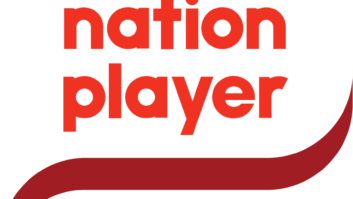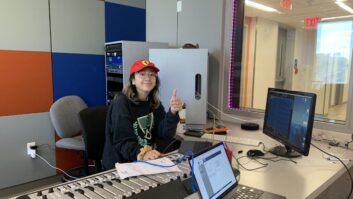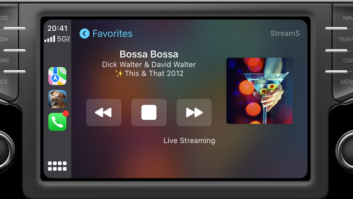In 1991, Youth Radio was launched in Berkeley, Calif. Its goal was to give economically disadvantaged kids the chance to find a future in radio by giving them a free after-school education in broadcasting.
Seventeen years later, Youth Radio is thriving. Though branching into video and the Web, the goal remains the same. Working out of its new broadcast facility in downtown Oakland, Youth Radio gives young people the chance to get their hands dirty in media, with an eye to building marketable skills.
(click thumbnail)Reporter/Producer Denise Tejada joined Youth Radio at age 17. Now 22, she leads its Spanish-language programming.
“Oakland is a high-crime city that is among the top 10 murder cities in the United States,” said Jacinda Abcarian, a Youth Radio grad (class of ’93) who has since become the organization’s executive director.
She has worked as a reporter for WRFG(FM) in Atlanta and as an intern at NPR and won awards including a Golden Reel from the National Federation of Community Broadcasters and the Alfred I. DuPont-Columbia Silver Baton Award.
“Eighty-five percent of our kids come from low-income neighborhoods and the rest are from more affluent neighborhoods throughout the Bay Area. Our goal is to give all of them the chance to find themselves in media; whether as a career or a form of self-expression.”
The station will hold a grand opening on Sept. 21 at its new home at 1701 Broadway in Oakland. It purchased the building in January 2006 and moved from Berkeley in June of 2007 after renovations.
The program
Every year, about 1,300 youth age 14 to 18 take part in Youth Radio’s free programs. Most do so at the Oakland production center. Youth Radio also conducts classes in some area high schools and teaches at Camp Sweeney detention facility in San Leandro.
To qualify, students fill out a two-page questionnaire and are interviewed by Youth Radio staff.
The courses offered give a sense of Youth Radio’s curriculum. The introductory “Core” media training program runs 11 weeks, during which time students are taught basic journalism and broadcast skills, including news and commentary writing, on-air announcing, music programming, Web and video production.
In the intermediate “Bridge” course, the kids spend 11 more weeks after-school specializing in an aspect of media that appeals to them like news, radio broadcasting, music, Web or video.
Once students pass intermediate level, they can intern at Youth Radio as peer teachers, producers and production staff. They can “job shadow” professionals in media, communications technology or social justice organizations.
Money for YouthThese are some of the organizations that support non-profit Youth Radio, according to its Web site:
Alameda County Health Care Services Agency
Blue Shield of California Foundation
California Endowment
California Wellness Foundation
Corporation for Public Broadcasting
Ethics and Excellence in Journalism Foundation
Evelyn & Walter Haas Jr. Fund
Gap Foundation
The Hearst Foundations
James Irvine Foundation
Jessie V. and W. Clement Stone Foundation
Jenesis Group
Kaiser Permanente
Levi Strauss Foundation
National Endowment for the Arts
National Science Foundation
City of Oakland Cultural Arts & Marketing Division
City of Oakland Department of Human Services
Stuart Foundation
Surdna Foundation
Thomas J. Long Foundation
Wallace Alexander Gerbode Foundation
WK Kellogg Foundation
Zero DivideThose 18 to 24 who want to go further can take a six-month advanced course, “Emerging Media Professionals,” which covers public speaking, group facilitation, community networking, journalism and media production/distribution.
Distribution
The content produced by Youth Radio is very much driven by the students. Much of it is music-based, but news and current affairs play a big role.
“We just won two Gracie Allen Awards in New York for two of our features,” Abcarian says. “One looked at Hurricane Katrina and how it affected New Orleans youth. The other was about military deserters who have fled to Canada.”
Beyond being made available at www.youthradio.org, Youth Radio programs can be heard on National Public Radio. More than 300 Youth Radio reports and commentaries are broadcast each year on NPR’s “All Things Considered” and “Morning Edition” plus local public radio stations such as KQED(FM) in San Francisco and WABE(FM) in Atlanta. Youth Radio content can also be found on CNN.com, MTV Interactive and CBS.com.
“Anyone can produce a report and post it on YouTube,” says Abcarian. “But to produce quality content that fits on NPR — that’s what we help our students achieve.” Youth Radio content is also available on iTunes.
Challenges
Thanks to the design and installation guidance of Technical Director Tim McGovern, who has experience at Lucasfilm and Skywalker Ranch, Youth Radio’s Oakland facility is a modern radio facility.
“We have eight digital edit suites and three studios in our facility, and the ability to connect to any other station in the world using ISDN, Skype and broadband,” Abcarian says. “We also have three news bureaus; one in L.A., one in Atlanta and one in Washington, D.C. In addition, we have freelance reporters all over the world.”
Of course, nothing comes for free. To pay for its facilities and staff, Youth Radio relies on organizations such as the National Science Foundation and the Corporation for Public Broadcasting. With an annual budget that now hits $3.2 million, Abcarian is hoping to attract corporate sponsors as well. It is trying to raise $1 million to repay loans.
Is it money well spent? Many Youth Radio graduates have found jobs in the media. Moreover, others have found their ways into other promising careers, aided by the experience and maturity gained through the program. Youth Radio also is a place where Oakland young people can find an alternative to the tough life of the street, and hope that they can break the cycle of poverty and do something with their lives.
“For us, the challenge is to provide youth with opportunities in media, and to do it in ways that keeps pace with the changing distribution channels,” Abcarian said.
“That is why we are considering changing our name to Youth Media International, to better reflect what we do today. But whatever our name, our mission remains the same: We want to nurture young people’s intellectual, creative and professional growth through media training, and produce the highest quality original media for local and national outlets that we can.”
Asked later about the name change as this issue of Radio World was prepared, she said the organization will not officially change its name this year but will now include the tagline Youth Media International as well.













